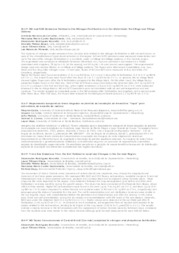NO and N2O emissions related to the nitrogen fertilization in a cornfield under No-tillage and tillage sistems.
NO and N2O emissions related to the nitrogen fertilization in a cornfield under No-tillage and tillage sistems.
Author(s): CARVALHO, A. M. de; BUSTAMANTE, M. M. C.; KOZOVITS, A. R.; SOUSA, D. M.; VIANA, L. T.; MIRANDA, L. de M.
Summary: The dynamic of nitrogen oxides emissions from Cerrado soils related to the nitrogen fertilization is still not well known, in spite of the intensification of agricultural activities in this region. NO and N2O emissions were measured immediately and up to five days after nitrogen fertilization in a cornfield, under no-tillage and tillage systems, in the Cerrado region. The experiment was conduced at EMBRAPA-Cerrados (Planaltina-DF), mucuna-preta/corn succession on a Oxisol. Associated with irrigation, 20 kg ha-1 N (at the sowing) and 60 kg ha-1 N-urea (cover) were applied. The experimental design used was random blocks, in no-tillage and tillage systems. The fluxes were determined immediately, one, two, three and five days after nitrogen cover. In each plot, fluxes of NO and N2O were measured in four and three PVC chambers, respectively. Higher NO fluxes were found immediately (4 to 6 ng NO-N cm-2 h-1) and 3 days after N fertilization (3.5 to 5.5 ng NO-N cm-2 h-1). The lowest fluxes were found after five days (0.7 to 2.7 ng NO-N cm-2 h-1). In general, the no-tillage block showed higher fluxes soon after the N fertilization compared to the tillage block. On the other hand, the tillage blocks presented higher fluxes in the third day. Most of the N2O fluxes values were below the detection limit (0.6 ng ng N2O-N cm-2 h-1), except in the first and third day, when higher emissions (2.6 and 0.63 ng N2O-N cm-2 h-1) were measured observed in the no-tillage blocks. NO and N2O emissions were not correlated with air and soil temperature and soil moisture. The results suggest an immediate pulse in the NO emission after fertilization and irrigation, and a second pulse after three days. After five days, the fluxes were reduced to the background levels (around 1.2 ng NO-N cm-2 h-1).
Publication year: 2004
Types of publication: Abstract in annals or event proceedings
Unit: Embrapa Cerrados
Observation
Some of Embrapa's publications are published as ePub files. To read them, use or download one of the following free software options to your computer or mobile device. Android: Google Play Books; IOS: iBooks; Windows and Linux: Calibre.
Access other publications
Access the Agricultural Research Database (BDPA) to consult Embrapa's full library collection and records.
Visit Embrapa Bookstore to purchase books and other publications sold by Embrapa.

